


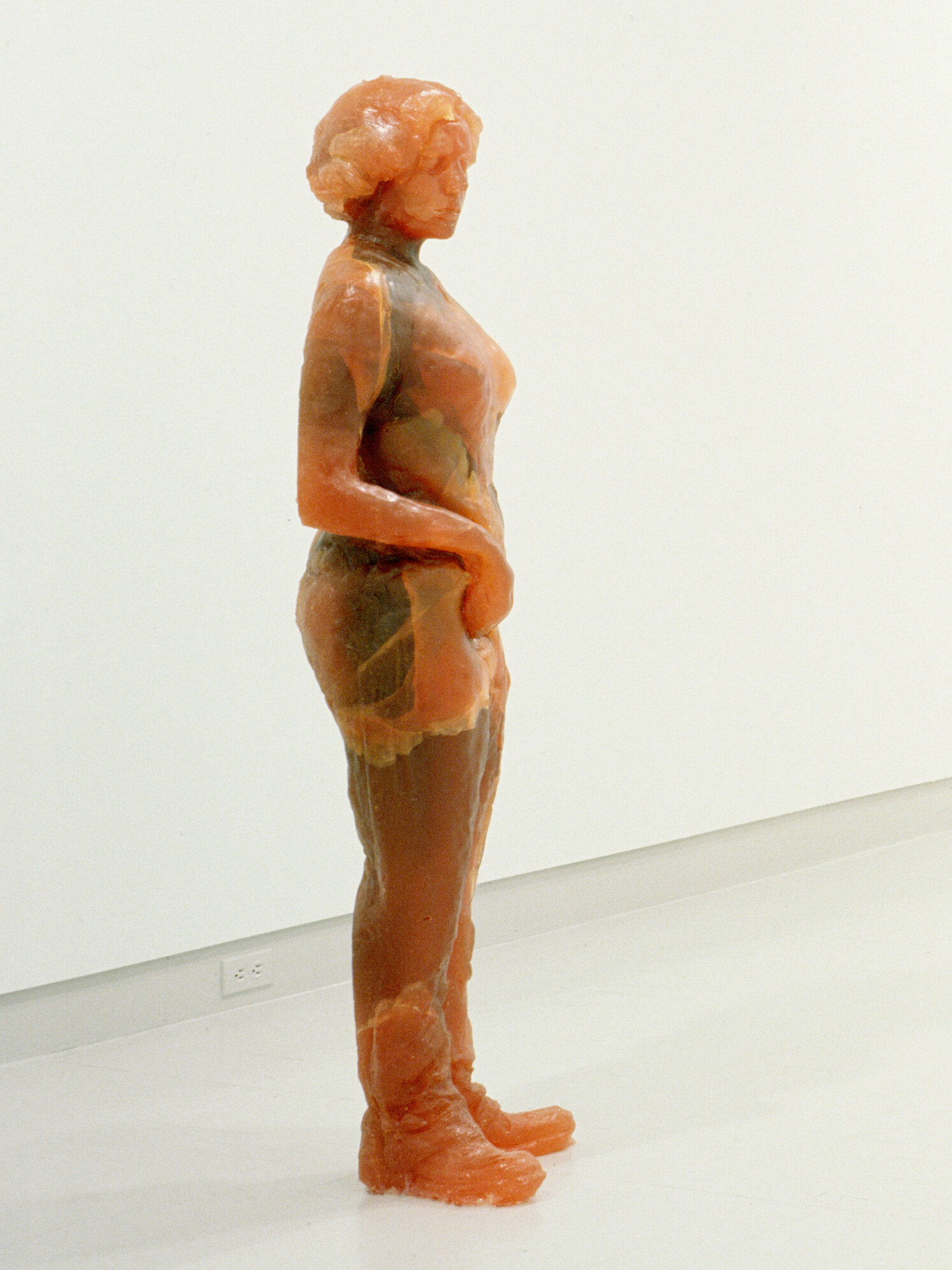
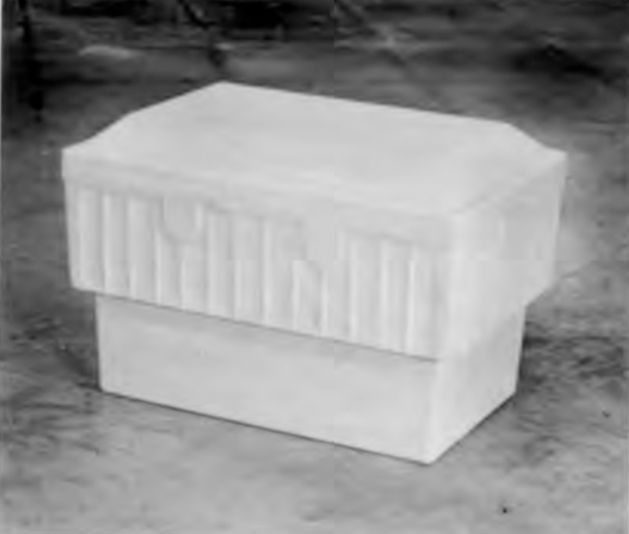
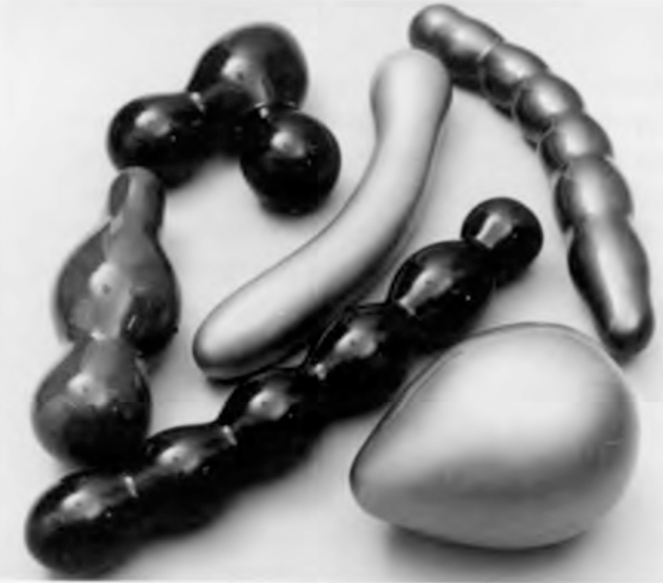
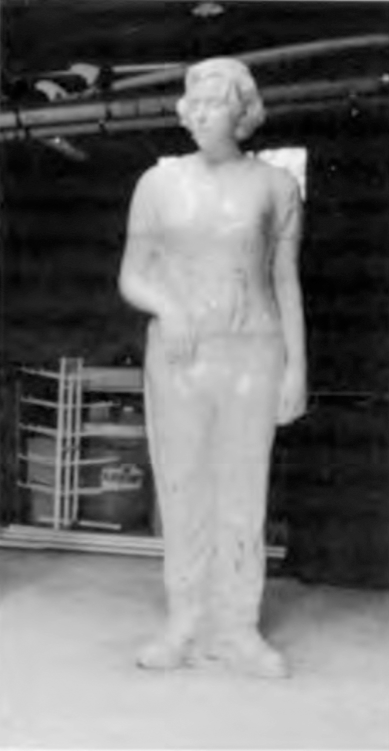



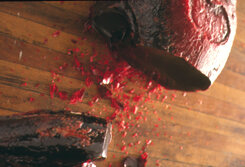

Installation view, 1:1 Recent Halifax Sculpture, SL Simpson Gallery, April 4-30, 1996, Toronto Canada (essay: Kenneth Hayes)
1:1, the scalar relation that denotes life-size, can stand as an emblem for the idea that has dominated recent sculptural practice in Halifax (1). This practice consists of reproducing ordinary objects a bucket, a piece of fruit or driftwood, a cabbage- at their original scale, but in different materials, sometimes by meticulous reconstruction, but often by direct casting (2). Variations of this practice have developed in the work of Lauren Schaffer, John Kennedy, Greg Forrest, Dona Hiebert, Davia Smith, Marcus Jones, and Kathyrn Ellis, as well as the artists in this show. The scale 1:1, with its attendant notion of the direct copy, declares that these artists give priority to problems of mimesis and reproduction over those other issues that have concerned sculptors, such as composition, site, and construction. It is also this scale that distinguished the work from Pop, for which inflated size was essential. Whether the approach is interpreted as appropriation, nominalism, or simulation, its particular conjunction of banality and cunning signals the legacy and continuing influence of Marcel Duchamp in the development of conceptual art at the Nova Scotia College of Art and Design, where these artists studied.

Installation view, Ninety-Sevens (1994-96), Phil Grauer; Cooler (1995) Thierry Delva (essay: Kenneth Hayes)
The interest of the work in this show lies in its varied responses to the specific relation proposed by the formula 1:1. The logic of 1:1 is not simply that of reciprocation, correspondence, reflection, or even equivalence, although it subsumes these relations without being exhausted. 1:1 makes the larger claim of identity, the very identity that underlines the concept of authenticity, and that permits the fantasy of a universal fungibility, that is, an ideal exchange without remainder or loss, one that is therefore infinitely repeatable. This proposition's very capacity to be expressed in the abstractions of number and symbol betrays its ambition to a code-like mastery that would overcome languages’ problem of translation. The model of this relation is money, since it is money that presents itself as the universal equivalent, despite being in itself utterly incapable of satisfying any human need.

Installation view, 1:1 Recent Halifax Sculpture, SL Simpson Gallery, April 4-30, 1996, Toronto Canada (essay: Kenneth Hayes)
The artists have engaged this relation, but not with the intention to realize or advance its ambitions, which they recognize as deeply counter-aesthetic. Theodor Adorno noted that (3) 1:1 is in this sense the negative moment of mimesis. These artists use laborious and ingenious techniques to duplicate banal objects, not with the aim to produce the perfect copy, which would be truly inane, but rather to assert precisely the non-identity of things and their artistic representations. Art objects, they assure us, are not just the same as other objects, no matter how life-like they are made. Representation is a distinct order within reality, and does not, as some claim, threaten our sense of the real; only those who stand to gain from confusing this matter would every say so. These works do not have the pious intention to be as real as possible; for them, the inverse of the old saying is closer to true: imitation is the sincerest form of mockery. 1:1, with its metaphysical promise of presence, is not the condition they desire to fulfill, it is the presumption they contest. The various ways in which they do this require individual readings, since it is out of this struggle with representation that they produce specific meanings.

Installation view, Sucker (1996) Lucy Pullen (essay: Kenneth Hayes)
The material candy provokes the taboo that prohibits an animal-like attitude toward the object, say a desire to devour it or otherwise to subjugate it to one's body. This provocation reinforces the work's pathos, which artists from it having only a being-for-display, a social relocation dominated by and restricted to a visual one. By suggesting an unrealizable or forbidden relation to the art object, the work protests the constraint that forces women to be images instead of makers of them. Transformation of one's self into a transcendent material, often crystal, is a persistent fantasy in the western mystical tradition, and it is particularly associated with women, such as Teresa of Avalia and Hildegard of Bingen. The false identification many women make of desiring only to be what is wanted of them: passive, quiet, composed, in a word sweet, is effectively critiqued by its literalization, which reveals it as grotesque. Adorno, with characteristic pessimism, advises that (7) sweetness in excess expresses its exact opposite, a bitter unfreedom.

Cooler, 1995, Thierry Delva (marble, photo: Marion Bryson, essay: Kenneth Hayes)
Of the sculptors in Halifax, Thierry Delva practices in the most purely mimetic mode. He produces relatively small, highly fini hed, objects that sit on the gallery floor alone, in small ensembles, or in scatters. His sculptures often fuse simple containers and their contents mto solid, monumental forms. His series of solid bronze flashlights even mimics the flashlight's beam by reflecting ambient light from the highly polished surface that represents the glass. The piece shown here, Cooler (1995) is a typical, styrofoam, picnic cooler that Delva has meticulously carved in the material that signifies traditional sculpture, white marble. The transposition of materials, from the cheap, faintly menacing, ubiquity of styrofoam to the distinct nobility and composure of marble, raises the ironic consciousness that Styrofoam, by virtue of being non-biodegradable, is the marble or our times, as likely to out-live our culture as antique funerary monuments survived theirs, only this time unintentionally, in defiance of our desire for disposability without cost. In fact, the Neoclassicism that was submerged in the banality or the model is recovered in the copy, and heightened by the elimination of lettering, manufacturing details, etc. The rigorous order, proportion, and balance or the sculpture is countered by its informal placement on the floor. Of course, this gesture responds to the technical imperative of post-minimal sculpture, that the pedestal be eliminated, but it also subtly evokes the scene or a picnic that is already suggested by the function of the initial object. When rendered in marble, the cooler is immediately recognizable as a sarcophagus. This identification in turn suggests the macabre notion of the Styrofoam cooler as morgue or cryogenic chamber. The work taps into the uncanniness of our efforts at preservation, whether directed toward food-stuffs, art objects, or ourselves. When this content joins with the bucolic scene suggested by a picnic, the work distinctly evokes the Neoclassical theme of Et in Arcadia Ego, the need to remember death in defiance of the bourgeois dream of rural freedom.
This evocation is heightened by leaving unanswered the obvious, even slightly annoying, question whether the marble is solid or not. Robin Metcalfe has speculated that the cooler, “... must contain a monumental, petrified picnic. (4) but in the classical tradition of the cenotaph, the tomb gained its emotional and representational depth precisely by being empty. The paradox whereby art fails to represent death, but in failing, succeeds as art, is surely the case with this work.
The same question also touches on the matter of the limits of the artist's commitment and labour. Adorno says of art works that, ‘However clearly they may have been actualized as durable products, owing for example to their material, they nevertheless have something momentary and sudden that is imparted to them by their act-like nature.’ (5) This is certainly the hinge of Delva's practice; it is as present in the flash of the flash-lights, as m the shudder produced when Cooler affirms the traditional link between death, coldness, and laughter. Delva's careful development of this fundamental quality of his work also explains how he reconciles his conceptual work with a highly developed skill that, insofar as it is traditional and craft-oriented, seems to be its antithesis, and definitely anachronistic. Delva is trained as a stone mason, and has worked on many restoration projects in Halifax, including the building that houses the Art Gallery of Nova Scotia where this work was first shown. Of course, building restoration differs from sculpture en direct in that it proceeds by copying. Delva's labour does not reaffirm craft for its own sake; instead, it reveals something that traditional procedures already have in common with a modern artifact that is mass-produced by injection moulding.

Ninety Sevens, 1994-1996, Phil Grauer (cast aluminum, automotive paint, photo: Rebecca Parsons, essay: Kenneth Hayes)
If these are bodies, as their tumescence suggests, they are clearly not ideal ones. By retreating as far as possible from geometry and construction, and adopting the glob as their basic idea, the sculptures allude to the informe, that which lies outside of, or defies, formation. The works manifest a will to formlessness, but also display not a little dread of the consequences of such a state, and understandably so, since form's opposite is strictly unimaginable. The project of depicting formlessness necessarily fails, but the attempt produces a radical condensation of egg, phallus, turd, breast, baby and worm. An abject, omni-sexuality leaks from the point where this project falls short; if these forms had not had this morbid rigidity, they might have consisted of collagen, silicon, semen, or lubricant barely contained by some thin membrane. Yet the specific character of the work arises from the fact that it treats failure as something more comic than tragic or terrifying. The polymorphous perverse is presented here as unthreatening, even cheerful, like the cartoon series in Playboy magazine that featured balloon figures in endless sexual permutations. A similarly comical take on the Oedipal complex of pedagogy informs a series of photos Grauer staged in which NSCAD faculty pose with the sculptures, forced into the roles of proud grandparent or swaggering colleague.
While the work's sexual content is barely below the surface, another, more abstractly formal, dimension is at play in its complex synthesis. Since all the forms are produced by the same means, their formal language is strongly consistent, but constitutes something more than merely variations on a theme. Seeing the works together suggests that each sculpture is capable of metamorphosing into the others it is like. Fantasies of morphing are strongly induced by metals in their liquid state, and are also a focus of ambitions for computer technology. The anxious conjunction of these ideas drove the movie Terminator II. Grauer has called the sculptures ·automobile dung', and certainly their relation to cars goes further than the lacquer finish. They point to the contemporary convergence of aerodynamic styling and computerized production, especially the somehow infantile, bulbous forms of the generation of auto bodies designed using spline patches and limiting algorithms. Grauer deflates the corporate spectacle of endless remodelling by equating it to a hobbyist's geeky enthusiasm for producing what he describes as a ‘computer simulation done in someone’s basement.’
Grauer's distinct position in recent Halifax sculpture has been to problematize the relation between sculpture and painting. He enacts a return to a mingling of artistic modes that had been repressed by an ascetic Conceptualism in NSCAD's history. The novelty of his approach is that he has done this not by using pictorial devices, but by using paint as a sculptural material. The works Grauer exhibited in the show Object Lessons at the Art Gallery of Nova Scotia consisted of found objects -a washing machine and dryer, and an outboard motor- that he painted in flesh tones. These are assisted readymades, but their transformation into sculpture has been effected only by painting. Indeed, the Ninety-Sevens, with their indeterminate forms and material substance completely obscured by surface and colour, seem to be a sculptor's fantasy of paint as a glistening blob, or even a painter's fantasy of sculpture.

Sucker, 1996, Lucy Pullen (plaster to be cast in hard rock candy, photo: Kathryn Pittman, essay: Kenneth Hayes)
Unlike the other artists in this show, Lucy Pullen does not identify herself primarily as a sculptor. Her work includes tiny constructions, computer animation, painting, marginal publications, food works, and counter-media tactics, and she is involved in the local music scene through the Dalhousie student radio station. Her work is marked by conceptual ambition, technical daring, and an antic humor. The piece shown here, Sucker, is a life-sized self-portrait cast in hard-rock candy. With this piece, Pullen boldly inverts the terms of Halifax sculpture: where other sculptors laboriously render banal objects in noble and honorific materials, she has produced the supreme icon of traditional art, the figure of a young woman, in a perishable and vulgar, 'pop', material.
The work effectively radicalized the practice of life casting that, as practiced by George Segal, Duane Hanson and others, and in Canada, notably by Evan Penny, was a conservative, even reactionary, part of the art of the sixties and seventies. It also moves beyond the familiar feminist practice of using dresses to metonymically represent the female figure. The sculpture's novelty could easily obscure the fact that is must count as one of what is undoubtedly a very small number or monumental self-portraits by Canadian artists.

Sucker (1996) Lucy Pullen (hard rock candy, (essay: Kenneth Hayes)
This inversion could be called the Karen Carpenter effect: it is not incidental that the work speaks to the bulimic-anorexic nexus that has been explored by Janine Antoni, Jana Sterbak, and numerous feminist artists. The work also has a great deal in common with the candy pieces by Felix Gonzales-Torres, not just by virtue of its material, but even more by the implied self-dissolution.
"Its just the saddest thing in the world" is a phrase Pullen often uses to express misgivings and dismay, sometimes over an art scene that is often bitterly divided. This hyperbole aptly describes her sculpture, with its defensive pose and excruciatingly slow collapse. To title a self-portrait Sucker is either a shockingly candid admission of gullibility or an affront to the viewer. Both meanings are no doubt intended. Pullen's approach is always knowingly ambiguous: in this case, the ineluctably to an image that, unencumbered by its material presence, could all the more readily circulate as media spectacle. Yet this possibility is one Pullen has not exploited. Her current work with computer animation for television enters the space of the spectacle itself, where she practices a game of complicity and subversion.

Street View, 515 Queen Street West, April 6, 1996 (photo: Gillian Pullen)
(1) For other accounts of recent Halifax sculpture see Metcalfe, Robin, Object Lessons Halifax: Art Gallery of Nova Scotia, 1995.; Peck, Robin, Ghosts: Sculpture photographed at Halifax Pier 21, C magazine (Spring 1994).; Sculpture Expo "94: The Mall Show, Canadian Art, 11:4 (Winter 1994)
(2) The new popularity of full-scale casting is partly due to the remarkable success of Rachel Whiteread, who has developed one small aspect of Bruce Nauman's early work into a complete practice.
(3) Adorno, Aesthetic Theory, p. 16. London: Routledge & Kegan Paul, 1984
(4) Object Lessons, p. 16
(5) Aesthetic Theory, p. 118
(6) This aspect of the work recalls Barnett Newman’s statement, “two feet of red is red but five feet of red is redder”.
(7) Mimina Moralia, p. 95, London: New Left Books, 1974
Travel assistance for the artists was provided by the Nova Scotia Department of Education and Culture. Lucy Pullen would like to thank Kerr Bros. Ltd. for their donation of candy for the exhibition.